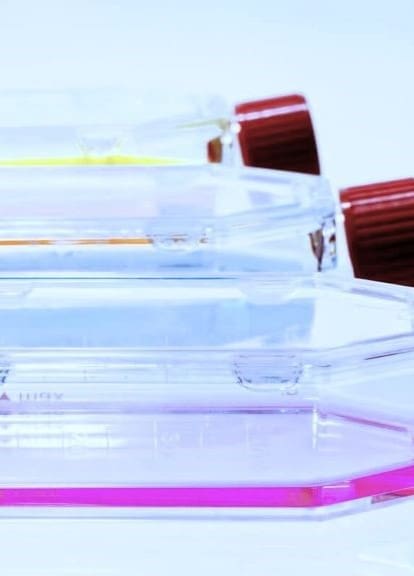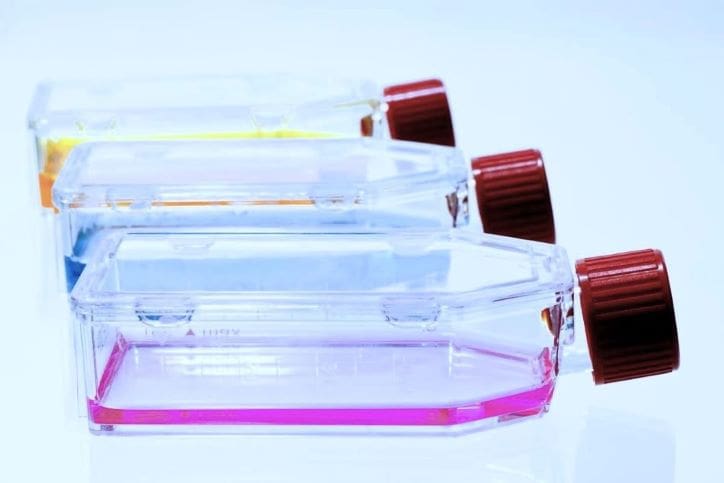To culture cells, cells are placed in a flask or plate with appropriate media, which provides the nutrients necessary for cell growth. The cell density at the time of seeding depends on the type of cells and the specific experiment. The cells are placed in an incubator which maintains the optimal conditions for cell growth. Mammalian cells are usually maintained at 37°C, 95% humidity, and a CO2 concentration of 5% 1,2. The cells are monitored regularly to assess cell growth and viability and to check for signs of contamination.
Traditionally, cell culture incubators have been designed for manual use. However, with the rise of automation in research laboratories, automated cell culture incubation has begun to gain traction 1.
In this article, we will discuss some key cell culture challenges and how automated cell culture incubators can help overcome these, as well as best practices for maintaining cell culture incubators to get the most out of your experiments.
Features of automated cell culture incubators
Automated cell culture incubators are a critical component of any fully automated laboratory. They allow cell lines to be maintained successfully by sustaining the optimal environmental conditions for cell growth and monitoring cells, minimising the human interference required during the cell culture process 1. This has several advantages over traditional manual cell culture, including:
- Accurate environmental control
Automated incubators precisely maintain the optimal environment for cell growth. The lack of human interference means that the temperature is not regularly dropping when users open doors to remove cells. This renders automation an effective way to decrease the variability commonly encountered with cell culture experiments.
- Improved sterility
Reducing the frequency of human interaction with cells limits the chances of contamination, a common issue in cell culture laboratories 3. Automated incubators can be kept much more sterile than traditional incubators which need to be opened and closed regularly throughout the day. Automated liquid handling is also advantageous for improving cell culture sterility. Improving sterility saves time and resources that are often wasted on failed experiments resulting from contamination.
- Reproducible results
Key reproducibility issues in cell culture stem from biological variability between cell passages 4. A recent EMBO report highlighted this, stating that severe cell line problems led to the rejection of ~4% of manuscripts 5. Automation of cell culture effectively overcomes reproducibility issues by standardising processes and minimising variability between passages of cells, as well as reducing the chances of human error leading to problems such as cell line misidentification.
- Increased productivity
Automation is an effective way to improve throughput, as capacity is not limited by the time taken for users to carry out monotonous, time-consuming cell culture maintenance tasks. For example, Automata’s cell biology systems have media exchange capacities that can be programmed to change cell media whenever required. This increases scalability and frees up researchers for tasks requiring human input, saving time and money and increasing scientists’ productivity. In addition, it reduces the need for researchers to work out of hours, improving work-life balance and laboratory safety.
Maintaining cell culture incubators
Maintaining cell culture incubators is an important task that involves routine cleaning to minimise the risk of contamination 2. Traditionally, incubator maintenance is done manually, a time-consuming task often carried out by highly skilled scientists. However, with more modern incubators, including automated incubator systems, many standard incubator maintenance tasks can now be done automatically, saving researchers time and increasing the efficiency and regularity of the process.
Standard incubator maintenance tasks that need to be performed regularly include cleaning and refilling the water pan and autoclaving the shelves and interior components. Together, these tasks effectively reduce the risk of microorganism contamination. Many modern incubator systems have inbuilt decontamination capabilities, reducing the time and effort involved in incubator cleaning and improving incubator sterility.
Another pivotal component of incubator maintenance is performing preventive maintenance based on the manufacturer’s instructions, such as replacing air inlet and gas supply line filters in a timely fashion. Automated systems can alert users when this is required, helping maintain optimal conditions and reducing the risk of incubator breakdown. Automata offers a range of automated solutions for cell biology workflows built on our LINQ platform.

Your Guide to the Future of Automated Cell Biology Labs
Start planning your lab’s automation journey with insights on building an impactful and futureproof roadmap.
LINQ: A new open, integrated laboratory automation platform
Our new open, integrated automation solution – LINQ – features a unique laboratory bench, with integrated automation capabilities and accompanying powerful, proprietary lab orchestration software.
As a result, labs can easily reduce human touchpoints and increase efficiency and accuracy without needing to dedicate additional lab space to bulky equipment.
References
1. Triaud F, Clenet DH, Cariou Y, Le Neel T, Morin D, Truchaud A. Evaluation of Automated Cell Culture Incubators. JALA J Assoc Lab Autom. 2003;8(6):82-86. doi:10.1016/s1535-5535(03)00018-2
2. Segeritz CP, Vallier L. Cell Culture. In: Basic Science Methods for Clinical Researchers. Elsevier; 2017:151-172. doi:10.1016/B978-0-12-803077-6.00009-6
3. Stacey GN. Cell Culture Contamination. In: Cree IA, ed. Cancer Cell Culture. Vol 731. Methods in Molecular Biology. Humana Press; 2011:79-91. doi:10.1007/978-1-61779-080-5_7
4. Geraghty RJ, Capes-Davis A, Davis JM, et al. Guidelines for the use of cell lines in biomedical research. Br J Cancer. 2014;111(6):1021-1046. doi:10.1038/bjc.2014.166
5. Souren NY, Fusenig NE, Heck S, et al. Cell line authentication: a necessity for reproducible biomedical research. EMBO J. 2022;41(14). doi:10.15252/embj.2022111307

